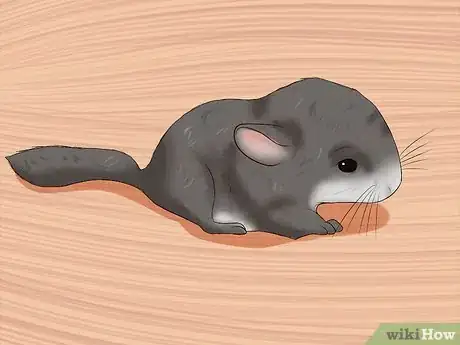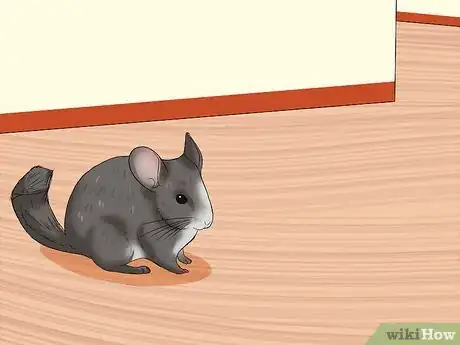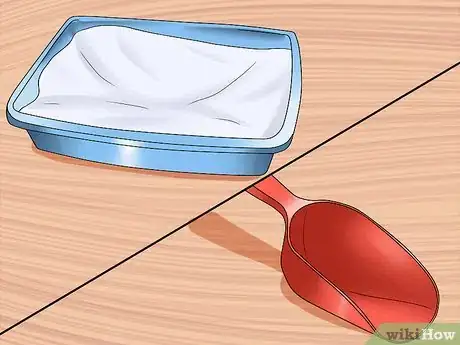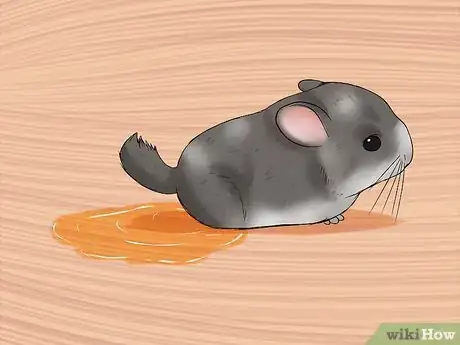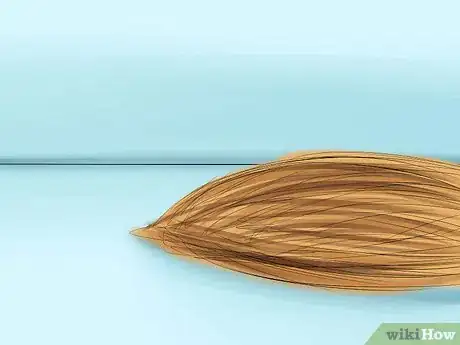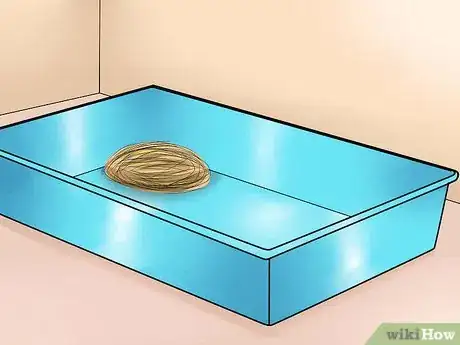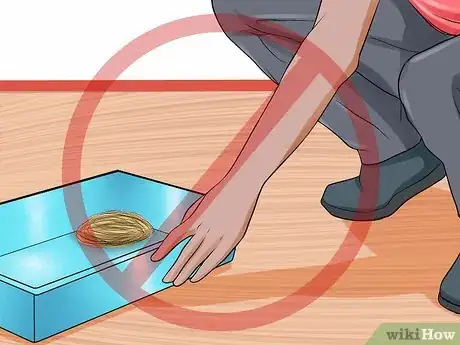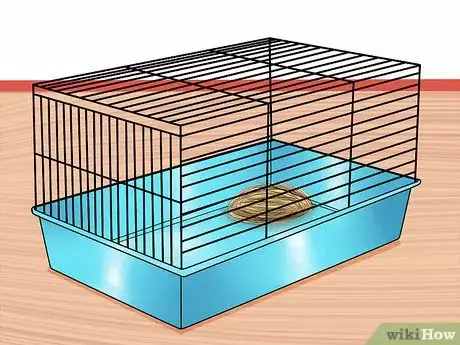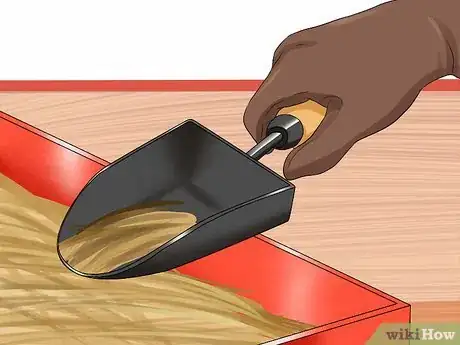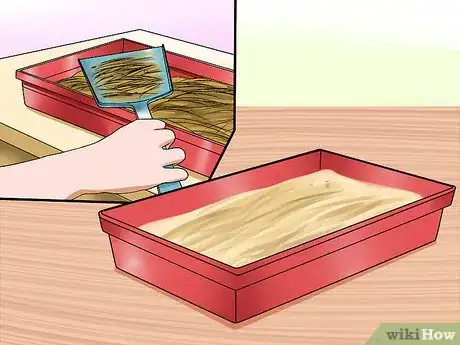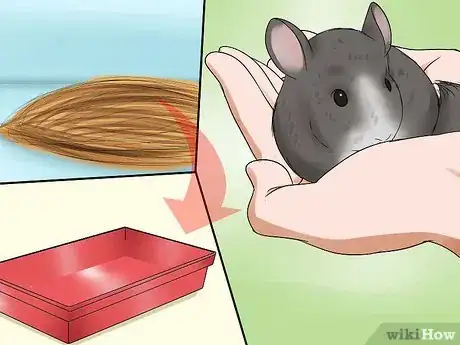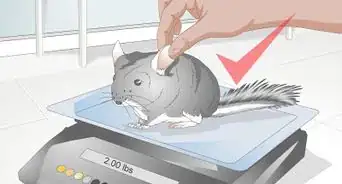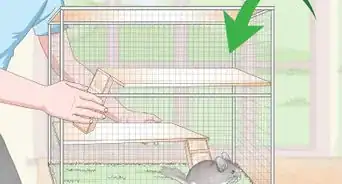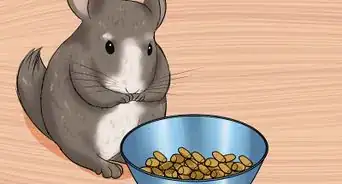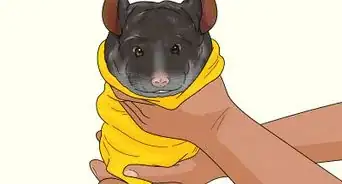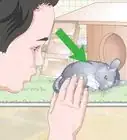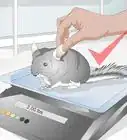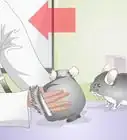This article was co-authored by Pippa Elliott, MRCVS. Dr. Elliott, BVMS, MRCVS is a veterinarian with over 30 years of experience in veterinary surgery and companion animal practice. She graduated from the University of Glasgow in 1987 with a degree in veterinary medicine and surgery. She has worked at the same animal clinic in her hometown for over 20 years.
wikiHow marks an article as reader-approved once it receives enough positive feedback. In this case, 100% of readers who voted found the article helpful, earning it our reader-approved status.
This article has been viewed 59,160 times.
Chinchillas are one of the most intelligent species of rodent, and many of them have been successfully potty trained by their owners. Most litter-box trained chinchillas still defecate around the cage, but can learn to urinate in the litter-box. With patience and a willing pet, you can train her to use a litter pan, reducing the mess and hassle of keeping such a large rodent. There are a couple of methods that different chinchilla owners have successfully used, so choose the one that makes the most sense for you.
Steps
Getting Started
-
1Start when your chinchilla is young. Like most animals, chinchillas are easiest to train when they are young and not yet set in their ways.[1]
- You can adopt a chinchilla around nine months old, but if you have younger chinchillas from a litter you can begin the potty-training process around six months old.[2]
-
2Let her adjust to her home first. Potty training can be a bit stressful for a chinchilla, so let her adapt to her new home before you try to begin the process.Advertisement
-
3Purchase potty training supplies. A few weeks after bringing home your chinchilla, head to your local pet supply store.
- You will need a litter pan, a litter scoop, and rodent litter. You can use a cat litter pan, but do not use cat litter, which rodents will ingest.
Using a Gradual Association Method
-
1Observe her habits. In order to potty train your chinchilla, you need to pay attention to where your chinchilla urinates. Then you can use this knowledge to gradually transition her from peeing on the floor to peeing in the box.
- Very young babies pee everywhere, but chinchillas around six months of age or older will develop a habit of using a particular place in their cage or enclosure as the "toilet" in order to keep all of their waste in one place and not contaminate the rest of the living quarters.
- Avoid cleaning her cage for a week in order to observe where she typically pees. A very young chinchilla who pees all over the cage is not likely to be ready to potty train. However, if you find that she typically pees in one spot or a particular corner, you can begin potty training her.[5]
-
2Begin to put less bedding down. Now that you know where she prefers to pee, you should gradually reduce the amount of bedding you put on the floor until you are only putting it in the areas she prefers to pee. Be sure to leave enough space for her to use the bathroom comfortably, but do not put bedding everywhere.[6]
- The goal for this step is to get her to begin associating the bedding itself with a toilet area. This step might take a week or two to gradually reduce the amount of bedding you put down in the floor of the cage.
-
3Replace the bedding with pans. Now that she has begun to associate certain areas of bedding with a toilet area, put the bedding in a litter pan or low-sided box and put the pan in the same area.[7]
- The goal for this step is to help her understand that not only is the bedding the appropriate place to pee, but the pan itself is the toilet.
- Although you might prefer to change the litter every day, try to go a few days between changing it so that you don't confuse her. As she gets more comfortable using her litter box, you can gradually begin to clean her box more frequently.
-
4Don't move the pan or change the bedding. It can be a few months before she is totally trained to use the box, and if you move the pan to another area in the cage or change the type of litter or bedding you are using, you might confuse her and set back your progress. Keep the pan itself the same, and keep it in the same position with the same filling for at least the first few months.
- When and if you do decide to change it, do so gradually. For example, do not suddenly go from putting the pan on the far right to the far left. Slowly move it a bit each day until it is in the position you prefer.
- Likewise, if you want to change the type of bedding, do it gradually by increasing the amount of the new type of bedding you want to use and slowly decreasing the amount of the old type until you've replaced it entirely.
Using a Waste Transfer Method
-
1Set up the cage. This method is different in that it requires putting the litter box in place from the start, but gradually training the chinchilla to use it instead of the bedding on the ground.
- Set the litter box on the very bottom level of her cage, next to the place where she typically urinates.
-
2Scoop your chinchilla's waste and place it in the litter box. Every few hours, come to your chinchillas cage and check whether she has used the bathroom in the bedding on the floor of the cage. If she has, scoop the waste and surrounding bedding and place it into the litter box.[8]
- Be sure to get all of the wet bedding. It carries a strong smell that will clue her in that you've moved her toilet.
-
3Change the litter box regularly. Chinchilla waste is pretty smelly, and you need to change the litter at least every couple of days to keep her cage smelling fresh.
- When you need to change her litter box, be sure to keep back one scoop's worth of urine-saturated bedding. Replace it on the top of the clean litter. This serves as a little signpost to your chinchilla to remind her that this area is the new toilet.
-
4Keep moving her soiled bedding to the litter box as long as it takes . This could be weeks or months! This method requires a lot of persistence on your part. If you forget to move the litter for a day or more, she will become confused and forget what you wanted her to do.
- Gradually, she should figure out that you want her to pee in the box and not on the ground.
Expert Q&A
-
QuestionCan you litter box train a chinchilla?
 Melissa Nelson, DVM, PhDDr. Nelson is a Veterinarian who specializes in Companion and Large Animal Medicine in Minnesota, where she has over 18 years of experience as a veterinarian in a rural clinic. She received her Doctor of Veterinary Medicine from the University of Minnesota in 1998.
Melissa Nelson, DVM, PhDDr. Nelson is a Veterinarian who specializes in Companion and Large Animal Medicine in Minnesota, where she has over 18 years of experience as a veterinarian in a rural clinic. She received her Doctor of Veterinary Medicine from the University of Minnesota in 1998.
Veterinarian Yes, you can train a chinchilla to urinate in a litter box. They usually will defecate throughout the cage.
Yes, you can train a chinchilla to urinate in a litter box. They usually will defecate throughout the cage. -
QuestionHow do you hold a chinchilla?
 Melissa Nelson, DVM, PhDDr. Nelson is a Veterinarian who specializes in Companion and Large Animal Medicine in Minnesota, where she has over 18 years of experience as a veterinarian in a rural clinic. She received her Doctor of Veterinary Medicine from the University of Minnesota in 1998.
Melissa Nelson, DVM, PhDDr. Nelson is a Veterinarian who specializes in Companion and Large Animal Medicine in Minnesota, where she has over 18 years of experience as a veterinarian in a rural clinic. She received her Doctor of Veterinary Medicine from the University of Minnesota in 1998.
Veterinarian With your hands around its torso, while supporting the chinchilla's rear end and legs.
With your hands around its torso, while supporting the chinchilla's rear end and legs. -
QuestionDo chinchillas poop on you?
 Melissa Nelson, DVM, PhDDr. Nelson is a Veterinarian who specializes in Companion and Large Animal Medicine in Minnesota, where she has over 18 years of experience as a veterinarian in a rural clinic. She received her Doctor of Veterinary Medicine from the University of Minnesota in 1998.
Melissa Nelson, DVM, PhDDr. Nelson is a Veterinarian who specializes in Companion and Large Animal Medicine in Minnesota, where she has over 18 years of experience as a veterinarian in a rural clinic. She received her Doctor of Veterinary Medicine from the University of Minnesota in 1998.
Veterinarian Yes, sometimes chinchillas can poop on you. Of course, this can be avoided.
Yes, sometimes chinchillas can poop on you. Of course, this can be avoided.
Things You'll Need
- Chinchilla cage
- Litter (bedding): try clean hay, kiln-dried pine shavings, newspaper
- Litter pan
- Litter scoop
Warnings
- Some chinchillas will ingest bedding of various types, so you may need to try one type and then switch it if you notice your chinchilla is eating it. Otherwise it can lead to internal blockage and even death. Chinchillas should not have any bedding that is made of paper, as it will expand and cause blockage. Recommended safe bedding is kiln dried aspen or pine.⧼thumbs_response⧽
References
- ↑ http://www.chinchillaclub.com/members/mag/1204tame.html
- ↑ http://www.sunsetchinchillas.com/PottyTrainingChinchillas.shtml
- ↑ http://www.sunsetchinchillas.com/PottyTrainingChinchillas.shtml
- ↑ http://www.chinchillarescue.org/adoptprocess.html
- ↑ http://www.sunsetchinchillas.com/PottyTrainingChinchillas.shtml
- ↑ http://www.sunsetchinchillas.com/PottyTrainingChinchillas.shtml
- ↑ http://www.sunsetchinchillas.com/PottyTrainingChinchillas.shtml
- ↑ http://www.chinchillaclub.com/members/mag/1204tame.html
About This Article
To potty train a chinchilla using the waste transfer method, start by putting a litter box filled with rodent litter next to the place it usually pees. Then, check the cage every few hours, and move any waste and bedding that’s soiled into the litter box, so your chinchilla will associate it with going to the bathroom. Make sure to change the litter box regularly, but keep 1 scoop of urine-saturated bedding to put on the clean litter as a reminder for your pet. Continue this for as long as it takes to train your chinchilla. For information from our Veterinary co-author about how to train your chinchilla using the gradual association method, read on!
